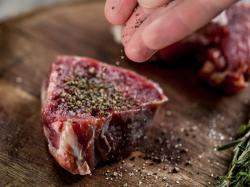‘What Should Eating Right Look Like?’
December 15, 2015 | 3 min to read

As increased obesity rates rose in importance to consumers and the nutrition community during the last decade, the beef checkoff has jockeyed to answer this pivotal question: “What should eating right look like?”
The answer, in short: Physical activity and eating right are important at all life stages, and the benefits last a lifetime!
Toward sharing this information with consumers and nutrition influencers, the checkoff talks about the protein equation, which addresses the general mix of foods and nutrients that make up a healthful diet. Meeting all nutrient needs within the calorie allowance allotted by age, gender and activity level can, however, be challenging when we look at “eating right.” For example, beef supplies significantly fewer calories and more complete nutrients than many plant proteins. It often takes more than twice the calories to get the same amount of protein from beans, nuts and grains compared to beef. For example, a 3-ounce serving of lean beef provides 25 grams of protein in less than 160 calories, on average. It would take 6 tablespoons of peanut butter (564 calories) or 1cups of black beans (382 calories) to provide the same amount of protein.
“Our beef checkoff has worked to develop more lean cuts of beef to meet protein and calorie needs that make for eating right,” says Cattlemen’s Beef Board member Jo Stanko, a cattle producer from Steamboat Springs, Colorado and member of the checkoff’s Nutrition and Health Committee. “In just 15 years, we helped quadruple the number of lean-beef cuts to nearly 40 to give consumers more options for ‘eating right’.”
The beef checkoff also led the way in questioning long-held assumptions about the negative nutrition effects of saturated fat. By taking an evidence-based research approach, the checkoff discovered that all of the various depictions of ‘eating right’ can include beef – even if it isn’t all lean beef.
For example, a common misperception is that the majority of the fatty acids in beef are saturated. In reality, however, half of the fatty acids in beef are monounsaturated, the same heart-healthy type found in olive oil. In addition, nearly one-third of the saturated fat in beef is stearic acid, a fatty acid that has been shown to have a neutral effect on LDL, or “bad” cholesterol. Learn more about the good fat in beef at fatty acid profile for beef.
“The portrait of ‘eating right’ can take as many forms as there are differences in consumers, but regardless of which healthful diet you choose to follow, we know and have research to prove that beef can play an important role,” says Stanko.
Learn about additional checkoff-funded peer-reviewed and published research about the power of protein in beef at Protein’s Role in the Human Diet. And for more information about your beef checkoff’s investment in human-nutrition research, visit BeefResearch.org and MyBeefCheckoff.com.
UNDERSTANDING THE BEEF CHECKOFF PROGRAM
The Beef Checkoff Program was established as part of the 1985 Farm Bill. The checkoff assesses $1 per head on the sale of live domestic and imported cattle, in addition to a comparable assessment on imported beef and beef products. States may retain up to 50 cents on the dollar and forward the other 50 cents per head to the Cattlemen's Beef Promotion and Research Board, which administers the national checkoff program, subject to USDA approval.
Source: The Beef Checkoff Program
